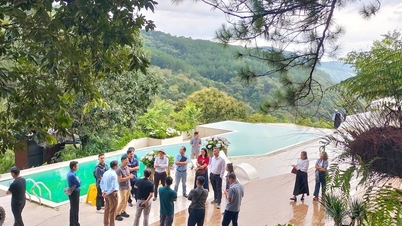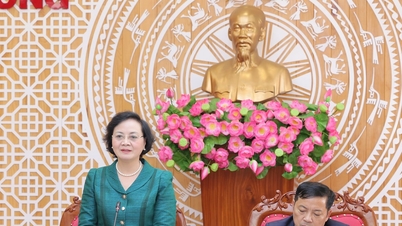According to the schedule, every 3 to 5 years, the Mnong Pre people in Nam Nung commune ( Lam Dong ) together organize the Tam Blang m'prang bon ceremony (bon fence ceremony, planting Blang trees) to thank the god Blang for protecting the village, and at the same time pray for favorable weather and good crops.
For the Mnông Pré people in Nam Nung commune, the Blang tree (cotton tree) represents the belief in the power of the gods to protect and shelter the village to overcome all difficulties. Therefore, the Bon fencing ceremony and Blang tree planting ceremony is considered one of the typical rituals, with the participation of many villages in the area, to thank heaven and earth for giving favorable weather and wind, and the Blang tree has protected and sheltered the villagers to overcome many difficulties in life.
The bon fencing and Blang tree planting ceremony is a very important ceremony, so all the rituals take place according to tradition. Before the ceremony takes place, the village elders and prestigious people gather the villagers to discuss and agree on the date of the ceremony and the location of the Blang tree planting, and at the same time assign specific tasks to everyone in the bon. The young men go into the forest to choose beautiful bamboo trees to erect the pole; the women take care of brewing rice wine, cooking rice, practicing singing and dancing, etc.
On the main day of the ceremony, the rituals of the Rung Bon Ceremony and Blang tree planting are held very solemnly. The offerings include a jar of rice wine placed next to the Blang tree, 3 eggplants, rice, turmeric, green chili, beeswax lamp, cotton-wrapped charcoal, a bowl of white rice... All the offerings are placed on banana leaves, except for the bitter eggplants and green chili placed on another leaf. The ceremony begins with the ritual: The celebrant comes to the jar of rice wine placed next to the pole, takes a tube of first-water wine and then pours a little on the pole, the altar, and the Blang tree; at the same time, takes a little wine and sprays it on the offerings. At this time, the people attending the ceremony hold the shaman's hand, lean on the Blang tree and proceed to plant the tree.
In the sound of the drums and gongs, the shaman began to pray: “Oh gods, Yangs, today at this place we ask the gods to come and witness the ceremony of planting trees at the Chu Pah volcanic cave. We plant this Blang tree and ask the gods to take care of it so that it grows well. We also ask the Yangs to take care of the villagers so that they can be healthy, free from illness, and free from social evils. At this place, we hold a ceremony to call the sacred gods here to drink rice wine and eat pork with the villagers. This is our offering to the Yangs…”.
After the worshiping ceremony, the celebrant invited the people and guests to join in the fun with a jar of rice wine, enjoy bamboo-tube rice, grilled meat, and the festival began when the campfire was lit. People invited guests to drink rice wine, enjoy specialties picked by the people from the forest and fields, and exchange traditional cultural and artistic activities. The later the night, the more the music and lyrics of the artisans, the old, the young, men and women, resonated, blending together melodiously with the wind of the great forest... creating an endless melody, contributing to strengthening the solidarity of the ethnic groups in the area.
According to the Y Tieng village elder, Bon Ja Rah, in the minds of the Mnong Pre people, the Blang tree planted in the Rao Bon ceremony is a symbol of the community's strength in the face of all difficulties and challenges in life. The Rao Bon ceremony and Blang tree planting is an opportunity for the previous generation to tell their descendants the meaning of the ceremony and teach their descendants to work together to preserve and conserve the beautiful identity of their ethnic group.
Source: https://baolamdong.vn/le-tam-blang-m-prang-bon-cua-nguoi-mnong-395215.html



![[Photo] President Luong Cuong attends the 80th Anniversary of the Traditional Day of Vietnamese Lawyers](https://vphoto.vietnam.vn/thumb/1200x675/vietnam/resource/IMAGE/2025/10/09/1760026998213_ndo_br_1-jpg.webp)
![[Photo] General Secretary To Lam visits Kieng Sang Kindergarten and the classroom named after Uncle Ho](https://vphoto.vietnam.vn/thumb/1200x675/vietnam/resource/IMAGE/2025/10/09/1760023999336_vna-potal-tong-bi-thu-to-lam-tham-truong-mau-giao-kieng-sang-va-lop-hoc-mang-ten-bac-ho-8328675-277-jpg.webp)


![[Photo] Prime Minister Pham Minh Chinh chairs a meeting of the Government Standing Committee on overcoming the consequences of natural disasters after storm No. 11](https://vphoto.vietnam.vn/thumb/1200x675/vietnam/resource/IMAGE/2025/10/09/1759997894015_dsc-0591-jpg.webp)



























































































Comment (0)